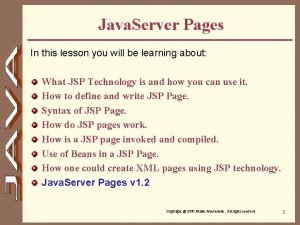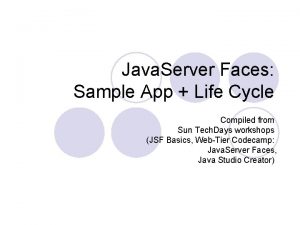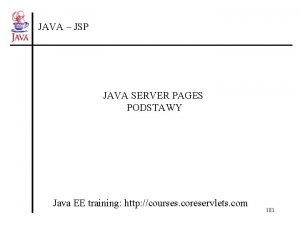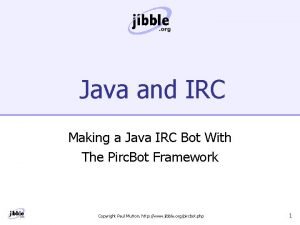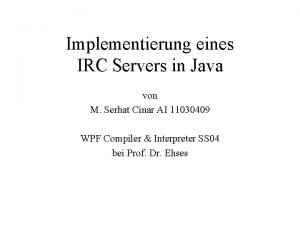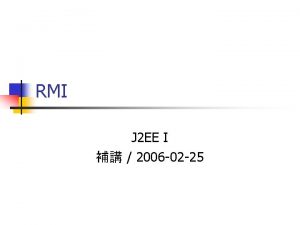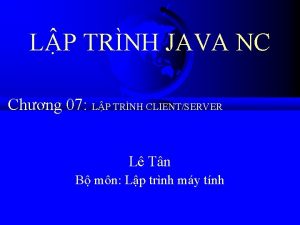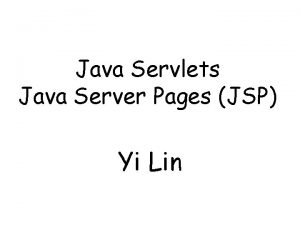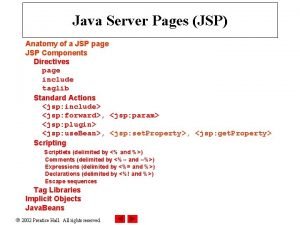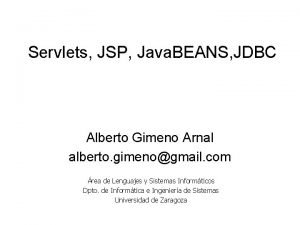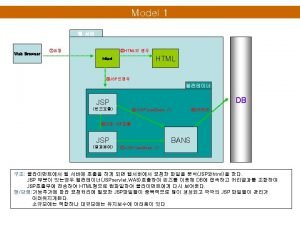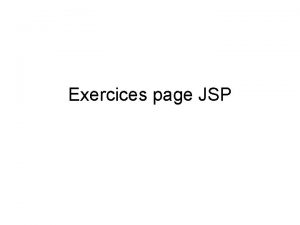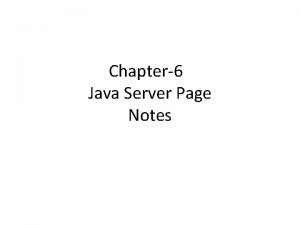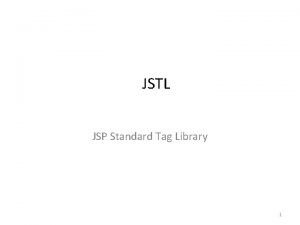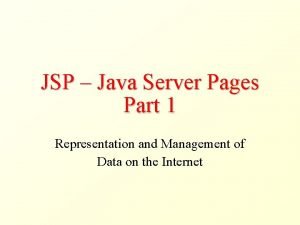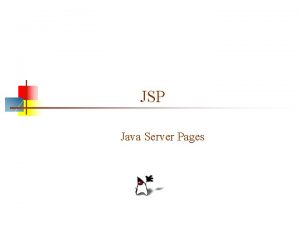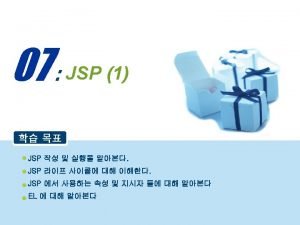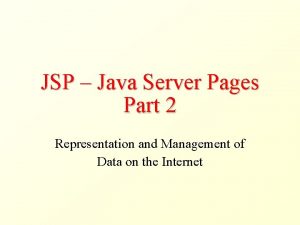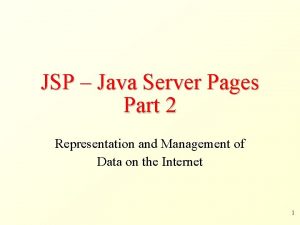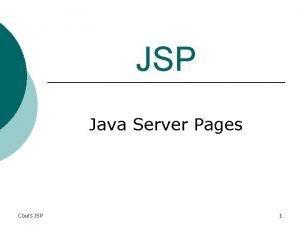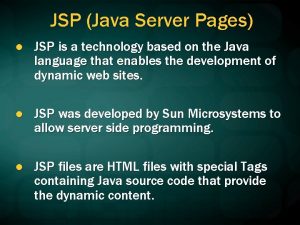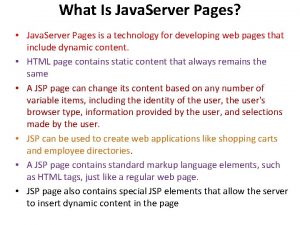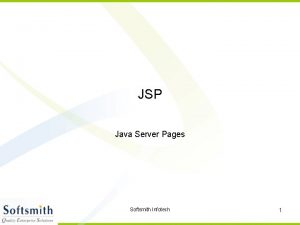JSP Java Server Pages Part 2 Representation and
















































- Slides: 48

JSP – Java Server Pages Part 2 Representation and Management of Data on the Internet

Interacting with other Resources

JSP Cooperation • We will consider several ways in which JSP and other resources cooperate - Forwarding the request handling to other resources - Including the content of other sources - Including the code of other JSP files - Forwarding exception handling to other JSPs

Actions • JSP actions use constructs in XML syntax to control the behavior of the Servlet engine • Using actions, you can - forward the request to another resource in the application - dynamically include a resource content in the response

The forward Action • jsp: forward - Forwards the requester to a new resource <jsp: forward page="{relative. URL|<%= expression %>}"> <jsp: param name="parameter. Name" value="{parameter. Value | <%= expression %>}" /> * </jsp: forward> • This action is translated to an invocation of the Request. Dispatcher

The include Action • jsp: include - Include a resource content at run time <jsp: include page="{relative. URL|<%= expression %>}"> <jsp: param name="parameter. Name" value="{parameter. Value | <%= expression %>}" />* </jsp: include> • This action is also translated to an invocation of the Request. Dispatcher

The include Directive • This directive lets you include files at the time the JSP page is translated into a Servlet • The directive looks like this: <%@ include file="url" %> • JSP content can affect main page • In Tomcat 5. x, generated Servlet is updated when included files change (unlike old versions. . . )

Include - Action File 1. jsp HTML content Servlet 1 HTML content File 2. jsp Servlet 2 HTML content

Include Directive File 1. jsp File 2. jsp Servlet HTML content

include Action vs. Directive • When a resource is included using the include action, the generated Servlet uses the dispatcher to include its content at runtime • When a file is included using the include directive, the file itself is included verbatim into the JSP code, prior to the Servlet generation • Question: in which of the above options can the included element change the HTTP headers or status?

Bla. jsp <html> <head><title>Including JSP</title></head><body> <h 2>Here is an interesting page. </h 2> <p>Bla, Bla. </p> <%@ include file="/Access. Count. jsp" %> <jsp: include page="/dbimail. jsp"/> </body></html> Access. Count. jsp <%! private int access. Count = 0; %> <hr><p>Accesses to page since Servlet init: <%= ++access. Count %></p> dbimail. jsp <hr><p> Page Created for Dbi Course at <%= new java. util. Date() %>. Email us <a href="mailto: dbi@cs. huji. ac. il">here</a>. </p>

Bla. Bla_jsp. java out. write("<html>rn"); out. write(" <head><title>Including JSP</title></head>rn"); out. write(" <body>rn"); out. write(" <h 2>Here is an interesting page. </h 2>rn"); out. write(" <p>Bla, Bla. </p>rn"); out. write("<hr>rn"); out. write("<p> rn"); out. write(" Accesses to page since Servlet init: rn"); out. print( ++access. Count ); out. write("</p>rn"); org. apache. jasper. runtime. Jsp. Runtime. Library. include(request, response, "/dbimail. jsp", out, false); out. write(" </body>rn"); out. write("</html>rn");

Included Counter • Suppose that the file Bla 2. jsp is similar the Bla. jsp • How will the counter of Bla 2. jsp act? • What if we used a JSP action instead of a JSP directive for the counter?

Error Pages • We can set one JSP page to be the handler of uncaught exceptions of another JSP page, using JSP directives • <%@ page error. Page="url " %> - Defines a JSP page that handles uncaught exceptions - The page in url must have true in the page-directive: • <%@ is. Error. Page="true|false" %> - The variable exception holds the exception thrown by the calling JSP

connect. jsp <html> <head><title>Reading From Database </title></head> <body> <%@ page import="java. sql. *" %> <%@ page error. Page="error. Page. jsp" %> <% Class. for. Name("oracle. jdbc. driver. Oracle. Driver"); Connection con = Driver. Manager. get. Connection ("jdbc: oracle: thin: " + "snoopy/snoopy@sol 4: 1521: stud"); %> <h 2>Connection Established!!</h 2> </body> </html>

error. Page. jsp <html> <head><title>Connection Error</title></head> <body> <%@ page import="java. io. *" %> <%@ page is. Error. Page="true" %> <h 1>Oops. There was an error when you accessed the database. </h 1> <h 2>Here is the stack trace: </h 2> <pre style="color: red"> <% exception. print. Stack. Trace(new Print. Writer(out)); %> </pre> </body> </html>



Custom JSP Tags

Custom JSP Tags • JSP code may use custom tags - tags that are defined and implemented by the programmer • The programmer defines how each of the custom tags is translated into Java code • There are two methods to define custom tags: - Tag libraries - used in old versions of JSP - Tag files - much simpler, introduced in JSP 2. 0

Tag Libraries • A tag library consists of: - Tag handlers - Java classes that define how each of the new tags is translated into Java code - A TLD (Tag Library Descriptor) file, which is an XML file that defines the structure and the implementing class of each tag

A Simple Tag. Lib Example Date. Tag. java package dbi; import javax. servlet. jsp. Jsp. Exception; import javax. servlet. jsp. tagext. Simple. Tag. Support; import java. io. IOException; public class Date. Tag extends Simple. Tag. Support { public void do. Tag() throws Jsp. Exception, IOException { get. Jsp. Context(). get. Out(). print(new java. util. Date()); } }

<taglib> <tlib-version>1. 0</tlib-version><jsp-version>2. 0</jsp-version> <tag> <name>date</name> <tagclass>dbi. Date. Tag</tagclass> <body-content>empty</body-content> </tag> </taglib> dbi-taglib. tld <%@ taglib prefix="dbitag" uri="/WEB-INF/tags/dbi-taglib. tld" %> <html><body> <h 1>Hello. The time is: <dbitag: date/></h 1> </body></html> taglibuse. jsp

Tag Files • JSP 2. 0 provides an extremely simplified way of defining tags • The idea: for each custom tag, write a tag file tag. Name. tag that implements the tag translation using JSP code • This way, the programmer can avoid creating tag handlers and TLD files

The Simplified Example <%= new java. util. Date() %> date. tag <%@ taglib prefix="dbitag" tagdir="/WEB-INF/tags/" %> <html> <body> <h 1>Hello. The time is: <dbitag: date/></h 1> </body> </html> taguse. jsp

Other Capabilities of Custom Tags • Attributes - You can define the possible attributes of the Tags - These can be accessed during the Tag translation • Tag Body - Tag translation may choose to ignore, include or change the tag body

Java Beans in JSP

Motivation • Software components (e. g. objects, data structures, primitives) are extensively used in Web applications • For example: - Service local variables - Attributes forwarded in requests - Session attributes, like users information - Application attributes, like access counters

Motivation • Standard actions are used to manipulate components: declaration, reading from the suitable context, setting of new values (according to input parameters), storing inside the suitable context, etc. • Java Beans provide a specification for automatic handling and manipulation of software components in JSP (and other technologies. . . )

Java Beans: The Idea • Java Beans are simply objects of classes that follow some (natural) coding convention: - An empty constructor - A readable property has a matching getter - A writable property has a matching setter • Use JSP actions to access and manipulate the bean, and special action attributes to specify the properties of the bean, like its scope

Example 1: Access Counter In the following example, we use a Bean to maintain an access counter for requests to the pages

Counter Bean package dbi; Bean must reside in a package public class Counter. Bean { private int counter; Bean is created by an empty constructor public Counter. Bean() { counter = 0; } public int get. Counter() { return counter; } public void set. Counter(int i) { counter = i; } counter is readable and writable public void increment() { ++counter; } } other methods can be used Counter. Bean. java

<html> <head><title>Bean Example</title></head><body> <jsp: use. Bean id="access. Counter" class="dbi. Counter. Bean" scope="application"/> <% access. Counter. increment(); %> <h 1> Welcome to Page A</h 1> <h 2>Accesses to this application: <jsp: get. Property name="access. Counter" property="counter"/> </h 2> <a href="page. B. jsp">Page B</a></body> </html> invokes get. Counter() page. A. jsp

<html> <head><title>Bean Example</title></head><body> <jsp: use. Bean id="access. Counter" class="dbi. Counter. Bean" scope="application"/> <% access. Counter. increment(); %> <h 1> Welcome to Page B</h 1> <h 2>Accesses to this application: <jsp: get. Property name="access. Counter" property="counter"/> </h 2> <a href="page. A. jsp">Page A</a></body> </html> page. B. jsp

From the Generated Servlet dbi. Counter. Bean access. Counter = null; synchronized (application) { access. Counter = (dbi. Counter. Bean) _jspx_page_context. get. Attribute("access. Counter", Page. Context. APPLICATION_SCOPE); if (access. Counter == null) { access. Counter = new dbi. Counter. Bean(); _jspx_page_context. set. Attribute("access. Counter", access. Counter, Page. Context. APPLICATION_SCOPE); } }

Example 2: Session Data In the following example, we use a Bean in order to keep a user's details throughout the session

package dbi; public class User. Info. Bean { private String first. Name; private String last. Name; public User. Info. Bean() { first. Name = last. Name = null; } public String get. First. Name() {return first. Name; } public String get. Last. Name() { return last. Name; } public void set. First. Name(String string) {first. Name = string; } public void set. Last. Name(String string) {last. Name = string; } } User. Info. Bean. java

<html> <head><title>Information Form</title></head> <body> <h 1>Fill in your details: </h 1> <form action="info. A. jsp" method="get"><p> Your First Name: <input type="text" name="first. Name" /> <br/> Your Last Name: <input type="text" name="last. Name" /><br/> <input type="submit" /></p> </form> </body></html> info. Form. html

<jsp: use. Bean id="user. Info" class="dbi. User. Info. Bean" scope="session"/> <jsp: set. Property name="user. Info" property="*"/> <html> Match parameters to <head><title>Page A</title></head><body> corresponding properties <h 1>Hello <jsp: get. Property name="user. Info" property="first. Name"/> <jsp: get. Property name="user. Info" property="last. Name"/>, </h 1> <h 1>Have a nice session!</h 1> <h 2> <a href="info. B. jsp">User Info B</a></h 2> </body></html> info. A. jsp

<jsp: use. Bean id="user. Info" class="dbi. User. Info. Bean" scope="session"/> <jsp: set. Property name="user. Info" property="*"/> <html> <head><title>Page B</title></head><body> <h 1>Hello <jsp: get. Property name="user. Info" property="first. Name"/> <jsp: get. Property name="user. Info" property="last. Name"/>, </h 1> <h 1>Have a nice session!</h 1> <h 2> <a href="info. A. jsp">User Info A</a></h 2> </body></html> info. B. jsp

Advantages of Java Beans • Easy and standard management of data - Automatic management of bean sharing and lots more • Good programming style - Allow standard but not direct access to members - You can add code to the setters and getters (e. g. constraint checks) without changing the client code - You can change the internal representation of the data without changing the client code • Increase of separation between business logic (written by programmers) and HTML (written by GUI artists)

JSP Expression Language

JSP Expression Language • JSP expression language is a comfortable tool to access useful objects in JSP • This language provides shortcuts in Java. Scriptlike syntax • An expression in EL is written as ${expr} • For example: Hi, ${user}. <em style="${style}">Welcome</em>

EL Variables • JSP EL does not recognize JSP's implicit objects, but rather has its own set: param, param. Values, header. Values, cookie, init. Param, page. Scope, request. Scope, session. Scope, application. Scope • Each of these objects maps names to values • For example, use param["x"] or param. x to get the value of the parameter x

EL Variables (cont) • A variable that is not an EL implicit object is looked up at the page, request, session (if valid) and application scopes • That is, x is evaluated as the first non null element obtained by executing page. Context. get. Attribute("x"), request. get. Attribute("x"), etc.

Object Properties • In JSP EL, Property p of Object o is referred to as o[p] • Property p of Object o is evaluated as follows: - If o is a Map object, then o. get(p) is returned - If o is a List or an array, then p is converted into an integer and o. get(p) or o[p] is returned - Otherwise, treat o as a bean, convert p to a string, and return apply the corresponding getter of o • The term o. p is equivalent to o["p"]

An Example <% response. add. Cookie(new Cookie("course", "dbi")); session. set. Attribute("dbiurl", new java. net. URL("http: //www. cs. huji. ac. il/~dbi/index. html")); String[] strs = {"str 1", "str 2"}; session. set. Attribute("arr", strs); %> <html><head><title>JSP Expressions</title></head><body> <form method="get" action="el. jsp"> <h 2>Write the parameter x: <input name="x" type="text" /> <input type="submit" value="send" /></h 2> </form> </body></html> elcall. jsp

<%@ page is. ELIgnored="false" %> <html> <head><title>EL Examples</title></head> <h 1>Expression-Language Examples</h 1> <h 2>Parameter <code>x</code>: ${param["x"]} </h 2> <h 2>Cookie <code>course</code>: ${cookie. course. value}</h 2> <h 2>Header <code>Connection</code>: ${header. Connection} </h 2> <h 2>Path of session attr. <code>dbiurl</code>: ${session. Scope. dbiurl. path}</h 2> <h 2>Element <code>arr[${param. x}]</code>: ${arr[param. x]} </h 2> </body></html> el. jsp
 What is jsp file
What is jsp file Jsf sample
Jsf sample Java server pages
Java server pages Java server pages
Java server pages Servlet
Servlet Printed pages vs web pages
Printed pages vs web pages Active server pages paradigma
Active server pages paradigma Java jsp
Java jsp Java jsp
Java jsp Jsp servlet tutorial
Jsp servlet tutorial Jsp request
Jsp request Java ee jsp
Java ee jsp Representation invariant java
Representation invariant java Pircbot
Pircbot Java irc
Java irc Tcp udp socket programming in java
Tcp udp socket programming in java Java.rmi.server.codebase
Java.rmi.server.codebase Lập trình socket giao tiếp tcp client/server java
Lập trình socket giao tiếp tcp client/server java Knock knock server java
Knock knock server java Pages 294 and 295
Pages 294 and 295 A process is busy swapping pages in and out. *
A process is busy swapping pages in and out. * Jsp technology
Jsp technology Comment organiser son oral de brevet
Comment organiser son oral de brevet Jsp skopje
Jsp skopje Anatomy of jsp page
Anatomy of jsp page Climatic injury
Climatic injury Jsp 539
Jsp 539 Jsp engine
Jsp engine Jsp engine
Jsp engine The anatomy of a jsp page
The anatomy of a jsp page Introduction of jsp
Introduction of jsp Mvc architecture in jsp
Mvc architecture in jsp Jsp
Jsp Jsp jdbc
Jsp jdbc Jsp taglib directive example
Jsp taglib directive example Jsp include html
Jsp include html What is jsp
What is jsp Introduction to jsp
Introduction to jsp Standard actions in jsp
Standard actions in jsp Exercice 1 page
Exercice 1 page Jsp overview
Jsp overview Korean.jsp?include= site:com
Korean.jsp?include= site:com Jsp xss 취약점 해결
Jsp xss 취약점 해결 Jsp standard tag library
Jsp standard tag library Jsp database access
Jsp database access Jsp architecture diagram
Jsp architecture diagram Etiquetas jsp
Etiquetas jsp Define jsp
Define jsp Scriplets
Scriplets
